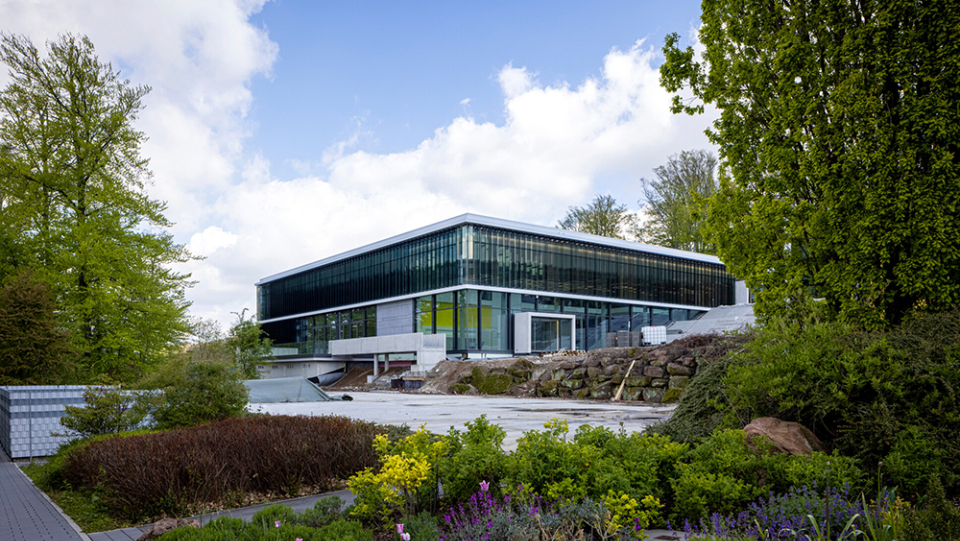
EMBL and BIS: Advancing Biological Imaging
The EMBL Imaging Centre has received €7 million in support from Boehringer Ingelheim Stiftung to further advance its cutting-edge imaging technologies.
Boehringer Ingelheim Stiftung (BIS) continues the successful development of the Heidelberg-based Imaging Centre (IC) of the European Molecular Biology Laboratory (EMBL), providing an additional €7 million to maintain and recruit additional highly qualified staff to further develop imaging technology services and make them accessible to the international research community. Back in 2017, when its construction was just being planned, BIS had already committed €5 million towards training and user support for two electron and light microscopy service teams.
“It’s an exciting time for the EMBL Imaging Centre, and this generous support from Boehringer Ingelheim Stiftung will make it possible to continue raising the level of research and services we can do here,” said Peer Bork, Interim EMBL Director General. “It ensures that the EMBL IC can maximise its service and training capacities and lay the foundation for continuing to be the leading centre in Europe in the future – the first to establish groundbreaking, next-generation imaging technologies with significant potential for impact in the life sciences as accessible services.”
With sites in Heidelberg, Barcelona, Grenoble, Hamburg, Rome, and EMBL-EBI in Hinxton, the EMBL brings together over 110 independent research groups and service teams – covering the entire spectrum of molecular biology. Since its opening in mid-2021, the EMBL IC has developed into an internationally recognised user facility for advanced microscopy technologies. By the end of 2024, its service teams will have supported over 290 research projects and training activities involving scientists from 27 countries and more than 120 scientific institutions. The EMBL IC uniquely combines two complementary missions: an internal research branch dedicated to the development of next-generation imaging methods, and a user-facing service facility supporting both academic and industrial research. While the majority of projects are academic in nature, a notable share involves collaboration with industry, underlining the centre’s broad relevance across sectors.
The Imaging Centre also hosts the Bio-Hub, headquarter for coordination of biological imaging services of the EU-wide Euro-BioImaging ERIC infrastructure, through which EMBL provides open access to cutting-edge imaging services.
A hallmark of the EMBL IC is its pioneering role in providing open access to emerging imaging technologies – including MINFLUX, label-free Brillouin microscopy, correlative imaging workflows, and real-time super-resolution microscopy. In addition to BIS, the Chan Zuckerberg Initiative (CZI) recently funded two multidisciplinary projects coordinated by the EMBL across multiple EMBL sites, supporting the development of two emerging technologies – HiTT2T and cutting-edge cryo-electron microscopy techniques for multiscale imaging.
MINFLUX
The Minimum Photon Flux Localization (MINFLUX) approach is specifically designed to visualize molecular movements with unprecedented resolution. Developed by Nobel laureate Stefan Hell, this technique builds on and surpasses earlier super-resolution localization microscopy methods such as STORM and PALM. By employing an optimized laser beam configuration, MINFLUX requires significantly fewer photons to excite fluorescent molecules, allowing for faster image acquisition with minimal photobleaching. MINFLUX currently provides the highest spatial and temporal resolution available in light microscopy, offering up to tenfold greater accuracy than previous techniques. Its dual-color capability enables researchers to simultaneously label transporter proteins such as Importin-α and nuclear pore complexes, tracking their interactions with nanometer spatial resolution and millisecond temporal resolution. MINFLUX has been used to study nuclear transport, revealing that molecules move through nuclear pore complexes via overlapping pathways, weaving around each other rather than using separate import and export routes. Compared to conventional microscopy techniques, MINFLUX allows for significantly longer tracking durations of individual molecules, enabling more detailed and continuous observation of dynamic cellular processes.
Brillouin microscopy
Brillouin microscopy is a label-free, non-invasive technique that measures the mechanical properties of biological samples by analyzing how light scatters off tiny, thermally driven vibrations within the material. This interaction slightly shifts the light’s frequency, revealing characteristics like stiffness or viscoelasticity at a microscopic scale. Unlike traditional methods that require direct mechanical contact or fluorescent labeling, Brillouin microscopy allows researchers to probe tissue and cell mechanics in 3D, without disrupting or damaging the sample. This makes it especially valuable for studying live cells, embryos, or light-sensitive organisms, where preserving physiological conditions is crucial. A recent EMBL breakthrough greatly increased the technique’s speed and resolution, enabling real-time full-field imaging of over 10,000 pixels—making it far more powerful for biological research.
Correlative multimodal imaging
The Electron Microscopy Core Facility of the EMBL IC covers a large spectrum of EM techniques. The main focus is on high-resolution ultrastructural analysis in 2D and 3D, immuno-EM and correlative multimodal imaging, combining EM with light microscopy, and X-ray microscopy or both. Correlative Light and Electron Microscopy (CLEM) combines the functional insights of light microscopy with the high-resolution structural detail provided by electron microscopy. It enables the correlation of fluorescence signals with detailed structural context within the same sample, allowing the precise localization of biomolecules within the cellular architecture. Correlative X-ray and Electron Microscopy (CXEM) combines the non-destructive 3D imaging by X-ray microscopy with the high-resolution structural detail of electron microscopy. This approach enables precise targeting of regions of interest within complex biological samples, bridging larger-scale structural context with ultrastructural analysis. For high-resolution imaging, the team collaborates with the PETRA III synchrotron facility in Hamburg.
Advanced light microscopy
The Advanced Light Microscopy Facility of the EMBL IC provides access to cutting-edge light microscopy systems and advanced image processing tools. In addition to established fluorescence techniques such as FRAP Fluorescence Recovery After Photobleaching (FRAP), Förster resonance energy transfer (FRET), and Fluorescence Correlation Spectroscopy (FCS) – used to analyze the mobility, interactions, and concentrations of fluorescently labeled molecules in living cells – the facility also offers laser nano-surgery to selectively alter or ablate specific regions within biological specimens. Ten dedicated High-Content Microscopy systems support large-scale screening projects. Twenty advanced imaging systems are available for super-resolution microscopy, including direct Stochastic Optical Reconstruction Microscopy (dSTORM), Stimulated Emission Depletion Microscopy (STED), and Total Internal Reflection Fluorescence Microscopy (TIRF). In addition to these established approaches, Lattice Light Sheet Microscopy (LLSM) offers a major advancement in real-time, high-resolution imaging. It combines exceptional temporal and spatial resolution with minimal phototoxicity, making it ideal for observing dynamic biological processes in living specimens.
HiTT2T
The High-Throughput X-ray Tomography to Targeted Transcriptomics (HiTT2T) project, led by EMBL Hamburg and Rome, aims to combine high-throughput 3D X-ray tomography with spatial transcriptomics to enable precise molecular characterization of entire tissue biopsies. High-throughput X-ray tomography is a non-destructive imaging method that rapidly generates high-resolution, 3D images of whole tissue samples without the need for staining or sectioning. By integrating detailed structural imaging with RNA-based molecular profiling, and supported by advanced data analysis from EMBL’s Data Science Centre, HiTT2T will reveal cellular heterogeneity in health and disease. This multi-modal pipeline is expected to improve diagnostics and personalised medicine by offering high-resolution, reproducible insights into tissue architecture and gene expression.
Cryo-electron microscopy techniques
Another project at EMBL focuses on advancing cryo-electron tomography and Cryo-Focused Ion Beam-Scanning Electron Microscopy (FIB-SEM) by developing plasma-FIB technology as a superior method for preparing complex multicellular samples. Cryo-FIB-SEM uses a focused ion beam to mill frozen biological samples at cryogenic temperatures, exposing thin slices that are then imaged with a scanning electron microscope to create high-resolution 3D reconstructions of cellular structures in their near-native state. Alongside automated software for high-throughput, gentle cryogenic sample preparation and 3D imaging, this work aims to improve analysis of tissue biopsies and disease models, offering new insights into cellular structures, disease mechanisms, and potential applications in precise diagnostics.


